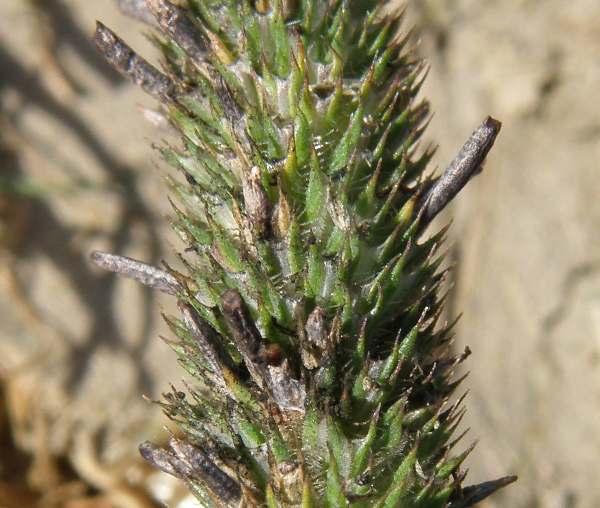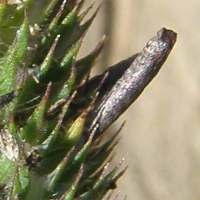Claviceps purpurea var. purpurea (Fr.) Tul. - Ergot
Phylum: Ascomycota - Class: Sordariomycetes - Order: Hypocreales - Family: Clavicipitaceae
Distribution - Taxonomic History - Etymology - Identification - Reference Sources

The name Ergot is applied to a group of similar tiny ascomycetes fungi that occur on grasses (including in the past some cereal crops). Their lifecycles are complex. The sclerotia develop in place of the seeds once spores of a Claviceps fungus have infected grass flowers. Ryegrass is particularly susceptible because of its open flower form. The Ergot mycelium then destroys the flower ovary and ultimately produces vast numbers of conidia (asexual spores) that can infect grass florets.
Ergot infects only the ovary of cereal and grass plants; other part of the plant are unaffected. Visible eventually as blackened sclerotia in the husks of the florets, Ergot contains toxic alkaloids. When eaten with grain these sclerotia are the cause of the illness known as ergotism, with such notorious symptoms as St Anthony’s Fire. (The name is a reference to The Brothers of St. Anthony, who developed treatments for victims of this ailment, and to the burning sensation in limbs resulting from eating Ergot-infected cereals.)
Distribution
Although widely distributed on wild grasses throughout Britain and Ireland as well as mainland Europe, North America and many other parts of the world, Ergot infection of cereal crops is normally kept to the required low level by appropriate farm management. This entails planting ergot-free seed and ploughing the land after harvest in order to bury crop residues and reduce the chance of ergot spores germinating in the following spring. Crops can be cleaned of ergot (and must be if for human consumption), but this is an expensive process and so infected grain has a much-reduced sale price.
Taxonomic history
The basionym of this ascomycete fungus dates from 1823, when Swedish mycologist Elias Magnus Fries described this species and gave it the scientific name Cordyceps purpurea. Its currently-accepted scientific name was established in 1883, when French botanist-mycologist Louis René (aka Edmond) Tulasne (1815 - 1885) transferred this species to the genus Claviceps.
Synonynms of Claviceps purpurea include Cordyceps microcephala (Wallr.) Berk. & Broome, Cordyceps purpurea (Fr.) Berk., Kentrosporium microcephalum Wallr., Sclerotium clavus DC., Sphaeria purpurea Fr., Sphacelia segetum Lév., and
Claviceps microcephala (Wallr.) Tul.
Etymology
The origin of the generic name Claviceps is the Latin noun clava meaning a club, with the suffix -ceps meaning head - hence club-head fungus. As you might expect, purpurea is a reference to the dark purple colour of the sclerotia.
Identification guide
 |
SclerotiaThe sclerotia (pictured above and left on a foxtail grass flowerhead) are banana-shaped; purple, becoming black; 1 to 2mm dia., and 1 to 1.5cm long; falling to the ground in winter, at which point the sexual stage of the lifecycle begins. |
AscosporesThe thread-like ascospores are typically 100 x 1µm. Spore colourCreamy-white. |
|
Habitat & Ecological role |
On untreated cereal crops and on grass seedheads. Rye and ryegrasses are particularly susceptible to this fungal infection. |
Season |
April to September in Britain and Ireland. |
Similar species |
The common name Ergot refers to many similar ascomycete fungi of the family Clavicipitaceae. |
Reference Sources
Fascinated by Fungi, 2nd Edition, Pat O'Reilly 2016, reprinted by Coch-y-bonddu Books in 2022.
Dennis, R.W.G. (1981). British Ascomycetes; Lubrecht & Cramer; ISBN: 3768205525.
Breitenbach, J. & Kränzlin, F. (1984). Fungi of Switzerland. Volume 1: Ascomycetes. Verlag Mykologia: Luzern, Switzerland.
Medardi, G. (2006). Ascomiceti d'Italia. Centro Studi Micologici: Trento.
Dictionary of the Fungi; Paul M. Kirk, Paul F. Cannon, David W. Minter and J. A. Stalpers; CABI, 2008
Taxonomic history and synonym information on these pages is drawn from many sources but in particular from the British Mycological Society's GB Checklist of Fungi.
Fascinated by Fungi. Back by popular demand, Pat O'Reilly's best-selling 450-page hardback book is available now. The latest second edition was republished with a sparkling new cover design in September 2022 by Coch-y-Bonddu Books. Full details and copies are available from the publisher's online bookshop...

